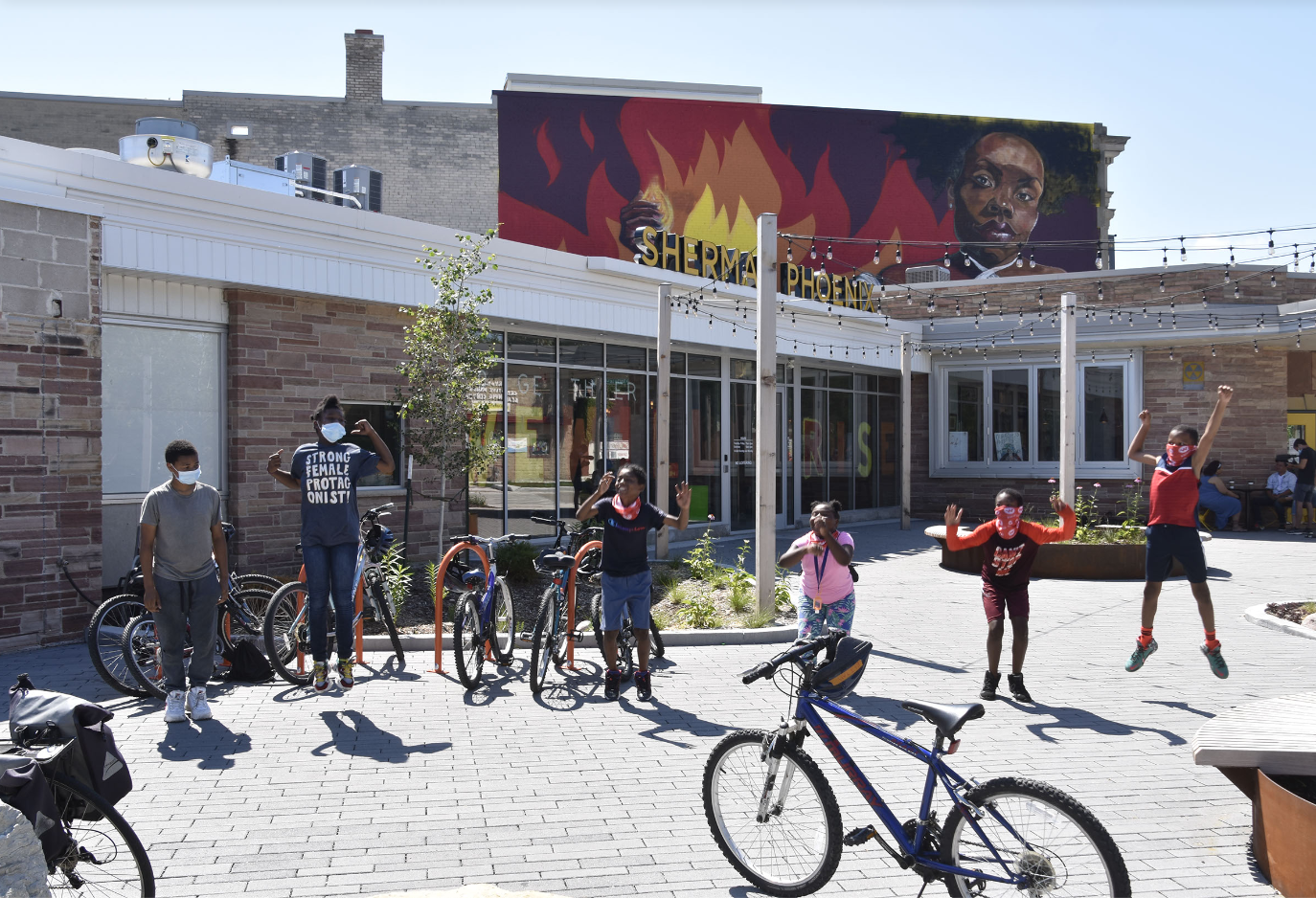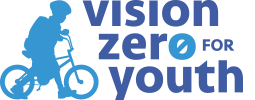Milwaukee SRTS Program: Advancing kids’ active travel during the COVID-19 pandemic
Winner of the 2021 Vision Zero for Youth Innovation Award! View the press release.
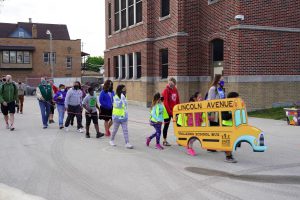 In 2021, the Milwaukee Safe Routes to School (SRTS) program, a partnership led by the Wisconsin Bike Fed (WBF) and city of Milwaukee Department of Public Works (DPW), received the Vision Zero for Youth Innovation Award from the National Center for Safe Routes to School for serving as a model of continued commitment to safe, active travel for children during the pandemic. As schools were forced to close and COVID-19 transmission prevention measures were put in place, the SRTS program adopted creative, community-driven approaches to continue its support for children’s active travel, with a priority for serving Black and Latinx communities.
In 2021, the Milwaukee Safe Routes to School (SRTS) program, a partnership led by the Wisconsin Bike Fed (WBF) and city of Milwaukee Department of Public Works (DPW), received the Vision Zero for Youth Innovation Award from the National Center for Safe Routes to School for serving as a model of continued commitment to safe, active travel for children during the pandemic. As schools were forced to close and COVID-19 transmission prevention measures were put in place, the SRTS program adopted creative, community-driven approaches to continue its support for children’s active travel, with a priority for serving Black and Latinx communities.
In February 2020, the SRTS program was in the midst of holding community workshops with students, school staff, teachers, parents and other stakeholders to identify priorities for infrastructure safety improvements around eight public schools serving low-income and Black or Latinx families selected through a prioritization process that used a combination of safety and equity criteria. Four workshops had taken place prior to the pandemic in which attendees used maps to identify problem areas and to recommend how to spend $75,000 on low-cost improvements. Despite significant challenges to advancing safety improvements around schools and engaging with communities in-person during the pandemic, DPW staff adapted by holding workshops and walks outside. Public involvement was modified into community walk audits and conducted outside with great success. As part of the walk audits, staff used chalk paint to draw outlines of potential infrastructure improvements to demonstrate how the project budget could be used at each school. These efforts ensured that physical distancing requirements were met while continuing to include parents, students, school staff, and neighbors in making decisions about street changes.
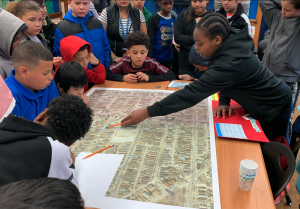 WBF staff attended the early workshops and saw an opportunity to better center youth voices in the design process. To do so, they worked with teachers and other school staff to engage students in cross-curricular activities, mapping the area around their school and developing street design ideas. Selected students presented their essays to an audience of various community leaders, including the local alderman. Teachers stated that they had never seen students so engaged in a school project before. Additionally, the design maps each student team created were sent to DPW staff to be analyzed alongside the initial public involvement maps. Both the Sixteenth Street Community Health Center and Northwest Side Community Development Corporation served as important partners in building action at schools.
WBF staff attended the early workshops and saw an opportunity to better center youth voices in the design process. To do so, they worked with teachers and other school staff to engage students in cross-curricular activities, mapping the area around their school and developing street design ideas. Selected students presented their essays to an audience of various community leaders, including the local alderman. Teachers stated that they had never seen students so engaged in a school project before. Additionally, the design maps each student team created were sent to DPW staff to be analyzed alongside the initial public involvement maps. Both the Sixteenth Street Community Health Center and Northwest Side Community Development Corporation served as important partners in building action at schools.
Between the workshops, surveys, and community walk audits, over 300 participants in diverse neighborhoods gave input on the SRTS infrastructure projects. Students, teachers, parents, and other community members were able to participate in each step of the design process, including identifying safety issues around each school, developing design alternatives, and making the final selection of the preferred alternative.
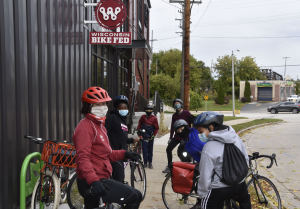 The WBF also continued its efforts to encourage safe bicycling and get children outside throughout 2020. Its summer bicycle camps for Milwaukee Public School students in fourth to eighth grade enrolled at a Community Learning Center were modified to allow them to continue despite COVID-19-related requirements and restrictions. Students received gear—including a branded WBF gaiter, surgical masks, hand sanitizer, a backpack with water bottle, and a booklet containing the curriculum—that made it possible to conduct all instruction outside. Bike storage was also adapted to enable distancing. Once bikes were fitted, students kept their bikes in a line with their backpack and helmets hanging on them to allow everything to be retrieved independently by students with limited contact from the Safe Routes instructors. Additionally, instructors limited movement between communities, opting to stay at one site rather than working at multiple sites in a day so that if someone contracted COVID-19, contact-tracing would be more effective. No cases in staff or students were reported. Adapting the camp sessions in this way enabled youth who might otherwise be indoors to be outdoors and physically active.
The WBF also continued its efforts to encourage safe bicycling and get children outside throughout 2020. Its summer bicycle camps for Milwaukee Public School students in fourth to eighth grade enrolled at a Community Learning Center were modified to allow them to continue despite COVID-19-related requirements and restrictions. Students received gear—including a branded WBF gaiter, surgical masks, hand sanitizer, a backpack with water bottle, and a booklet containing the curriculum—that made it possible to conduct all instruction outside. Bike storage was also adapted to enable distancing. Once bikes were fitted, students kept their bikes in a line with their backpack and helmets hanging on them to allow everything to be retrieved independently by students with limited contact from the Safe Routes instructors. Additionally, instructors limited movement between communities, opting to stay at one site rather than working at multiple sites in a day so that if someone contracted COVID-19, contact-tracing would be more effective. No cases in staff or students were reported. Adapting the camp sessions in this way enabled youth who might otherwise be indoors to be outdoors and physically active.
“It is remarkable in a city built on Lake Michigan how many students have never visited the waterfront before,” said Michael Anderson, Program Manager, Wisconsin Bike Fed. “All of our campers made it to the Lake. Students really gain a different perspective of their local geography through our rides and develop a deeper connection to the community. Rides range from two miles to 15 miles. It doesn’t have to be long to be meaningful.”
WBF also re-tooled many of its SRTS program elements into a “Safe Routes from Home” curriculum and made it compatible for school district-supplied student computers. They also began a new model of “Champion Training” in which WBF Instructors met school staff at their houses to tailor a riding experience for them and/or their family to their school site. One teacher took her students on weekly rides even when they were learning from home.
Nancy Pullen-Seufert, Director, National Center for Safe Routes to School, UNC Highway Safety Research Center, said the Vision Zero for Youth Award Committee wanted to recognize the Milwaukee Safe Routes to School Program and its partners for not only continuing but advancing its efforts to support safe walking and biking for youth, especially youth of color and in low-income neighborhoods, during the COVID-19 pandemic.
Milwaukee Mayor Tom Barrett noted, “Fostering the next generation of civic leaders is vital to ensuring healthy neighborhoods and safe streets in Milwaukee for decades to come. This award shows what can be achieved when everyone, especially our youth, brings their creativity and local knowledge to the table.”
“The Milwaukee Safe Routes to School Program provides an exceptional example of how organizations can come together to accomplish big things, even during incredibly challenging times such as those that communities have experienced during the COVID-19 pandemic,” Pullen-Seufert said. “We are honored to present the Vision Zero for Youth Innovation Award to a program that has gone to great lengths to continue its engagement of children, families, and other community members during a time marked by distancing.”
DPW Commissioner Jeff Polenske said, “The award highlights our department’s commitment to realizing safe and Complete Streets, especially around schools, by working with communities and building long-lasting relationships with partners such as the Wisconsin Bike Fed, Milwaukee Public Schools, and the Sixteenth Street Community Health Centers. We’re proud of the hard work these organizations, parents, students, and countless other neighbors undertake every day to make it easier for students and staff to bike or walk to school safely. We are excited to continue this work in the coming months and years as a leader in Milwaukee’s Safe Routes to School program.”
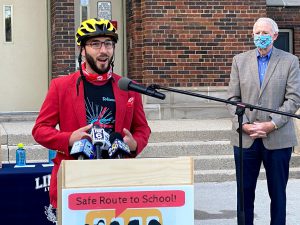 Anderson said, “The Wisconsin Bike Fed is grateful for this recognition by the National Center for Safe Routes to School. Our long relationship with Milwaukee Public Schools allowed us to creatively move our Safe Routes efforts forward during the pandemic. In 2021 we continue to support our young people in MPS virtually and in-person through after-school bike clubs, summer bike camps, and walking clubs. We are especially excited to collaborate with the Department of Public Works multimodal team again in the Fall 2021 school year and build upon our Child Friendly City work at Lincoln Avenue School including youth voices in the street design process.”
Anderson said, “The Wisconsin Bike Fed is grateful for this recognition by the National Center for Safe Routes to School. Our long relationship with Milwaukee Public Schools allowed us to creatively move our Safe Routes efforts forward during the pandemic. In 2021 we continue to support our young people in MPS virtually and in-person through after-school bike clubs, summer bike camps, and walking clubs. We are especially excited to collaborate with the Department of Public Works multimodal team again in the Fall 2021 school year and build upon our Child Friendly City work at Lincoln Avenue School including youth voices in the street design process.”
Anderson also noted that some changes made because of COVID are likely to continue, such as the monthly walking clubs.
“It’s a very simple concept but one that has proven to be a very effective engagement strategy,” he explained. “I am viewing it as a building block to more advanced programs such as Walking School Bus efforts. Getting a walking club started first will help build capacity and excitement for further SRTS efforts.”
